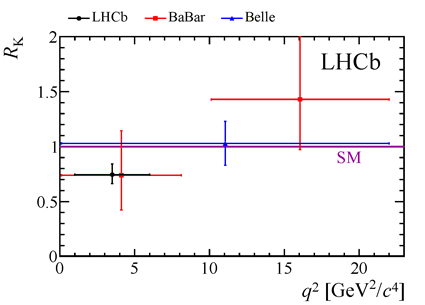The LHCb Collaboration has just presented at the Large Hadron Collider Physics (LHCP) Conference in New York an interesting result: the ratio RK of the probability that a B+ meson decays to a K+μ+μ– or a K+e+e– was measured to be different from one with a 2.6σ significance. The RK is the ratio of two rare processes that occur twice in 10 million events (2×10-7) representing b→s processes highly sensitive to the presence of virtual particles that only exist in extensions to the Standard Model.
In the Standard Model of particle physics this ratio is expected to be very close to one thanks to the so called lepton universality: leptons (like electrons e and muons μ here) behave in the same way (have the same couplings to the gauge bosons, for experts). The small differences in decay rates, tested so far with high accuracy, related mainly to the differences of their masses, are well understood. In the case of two decays discussed here the difference is expected to be at the per-mille level.
The ratio RK is measured in function of the μ+μ– and e+e– invariant mass squared q2. The LHCb result of RK = 0.745+0.090-0.074 ±0.036 measured in the q2 range between 1 and 6 GeV2 is shown in the image as the black point with error bars together with the results from other experiments. It is interesting to note that the result of BaBar Collaboration at low q2 shown by the red left point favors also a value below one. The blue point shows that the result of the RK measurement by the Belle Collaboration is consistent with one in the whole q2 range up to 22 GeV2. The Belle result does not, however, contradict a possible q2 dependence of RK which may be indicated by the BaBar results. As seen in the image the LHCb measurement is the most precise measurement of RK to date.
click the image for higher resolution
Studies of RK could detect the existence of additional Higgs bosons, new scalar or new pseudo-scalar particles that violate lepton universality, or “heavy Z”, Z’, which was suggested as a possible explanation of deviations observed in the P’5 distribution in the analysis of B0→K*0μ+μ– decays, see 9 August 2013 news.
The pp collision data corresponding to 3 fb-1 of integrated luminosity collected by the LHCb experiment at centre-of-mass energies of 7 and 8 TeV were used to obtain this result. It will be interesting to follow up with future LHCb measurements of RK at the 13 TeV pp collisions after the LHC restart planned for April 2015.
Read more in the LHCb presentation at the LHCP conference here, at the CERN public page here, in the Symmetry article, in the LHCb publication here, in the APS Physics Viewpoint and in the theorist’s comment in CERN Courier.

